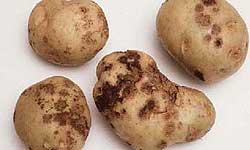Common scab of potatoes
Common scab of potatoes is a soil-borne disease caused by the bacteria-like organism Streptomyces scabies.
This organism attacks:
- potato stems
- potato stolons
- potato roots
- young, rapidly growing tubers, which stimulates the growth of unsightly corky tissue.
A severe infection can:
- reduce the marketable yield
- damage the eyes of seed potatoes
- reduce the market value of the crop.
Symptoms of common scab
The scab organism varies greatly, so there are different symptoms and a range of conditions under which the potato can be damaged.

Tubers affected by common scab can show either shallow or deep scabs, or a combination of both.
A shallow or surface scab is a superficial, roughened or russeted area on the tuber. Slight protuberances with depressed centres might form and are covered with a small amount of corky tissue.
A deep or pitted scab consists of lesions (areas of diseased tissue) that can be:
- 1mm to 10mm deep
- roughly circular
- up to 10mm in diameter
- surrounded by corky tissue.
Environmental conditions
Soil pH and soil moisture seem to be the most important factors affecting seasonal incidence and regional distribution of scab, but there are other factors that are not clearly understood.
Common scab can be particularly severe when potatoes are grown in neutral or alkaline soils (pH 7.0 and above). Some races of the organism can damage tubers at a pH of 5.0 or below, but it's generally accepted that the disease is usually controlled satisfactorily if potato soils are kept at pH 5.0 to 5.2. Within the range of pH 5.2 to 8.0, the severity of the disease increases with increasing alkalinity.
Warm and dry soil conditions can noticeably increase the incidence of the disease, particularly during the critical period of susceptibility to scab (2 and 5 weeks after tubers start to form).
Managing common scab
Use a combination of several control measures to prevent an outbreak of common scab. This is more effective than using just one control measure.
For example, controlled irrigation combined with a registered fungicide treatment results in better control than either treatment used on its own.
Use resistant varieties
The only economical means of long-term control is to use resistant varieties in soils where the problem recurs.
While no popular variety is resistant, the early types (Red Pontiac, Kennebec and Sequoia) are more susceptible than the medium- to late-maturing types (Sebago and Coliban).
Crop rotation
Long rotations of 3 to 5 years can reduce the severity of the disease.
You will ideally rotate with legumes, and exclude:
- beets
- carrots
- parsnips
- radishes.
Adequate moisture and timing of irrigation
Dry soil at the time when tubers start to form, and for the 5 weeks after that, will increase the chances of common scab occurring.
Irrigate regularly at this time and keep moisture at field capacity.
Soil management
- Avoid excessive use of lime, fresh animal manures and wood ash. If lime is necessary, don't raise the soil pH above 5.2. Ideally, use dolomitic lime after potatoes in the rotation.
- Applying sulphur to lower soil pH to between 5.0 and 5.2 can be useful in reducing the level of scab in some soils with high pH.
- Use acid-producing fertilisers and use ammonium sulphate as a source of nitrogen.
Reporting an unusual plant insect pest or disease
Report any unusual plant pest or disease immediately using our online reporting form or by calling the Exotic Plant Pest Hotline on 1800 084 881. Early reporting increases the chance of effective control and eradication.
Please take multiple good quality photos of the pests or damage to include in your report where possible, as this is essential for rapid pest and disease diagnosis and response.
Your report will be responded to by an experienced staff member, who may seek more information about the detection and explain next steps.
Report onlineReferences
Compendium of Potato Diseases (2001) ed. by Stevenson, W.R. and et al, American Phytopathological Society, St. Paul, MN, USA.
Mulder, A. and Trukensteen, L. J. (2005) Potato diseases, 2508 AC Den Haag The Netherlands.
Potato Health management (2008) ed. by Johnson, D.A. American Phytopathological Society, St. Paul, MN, USA.